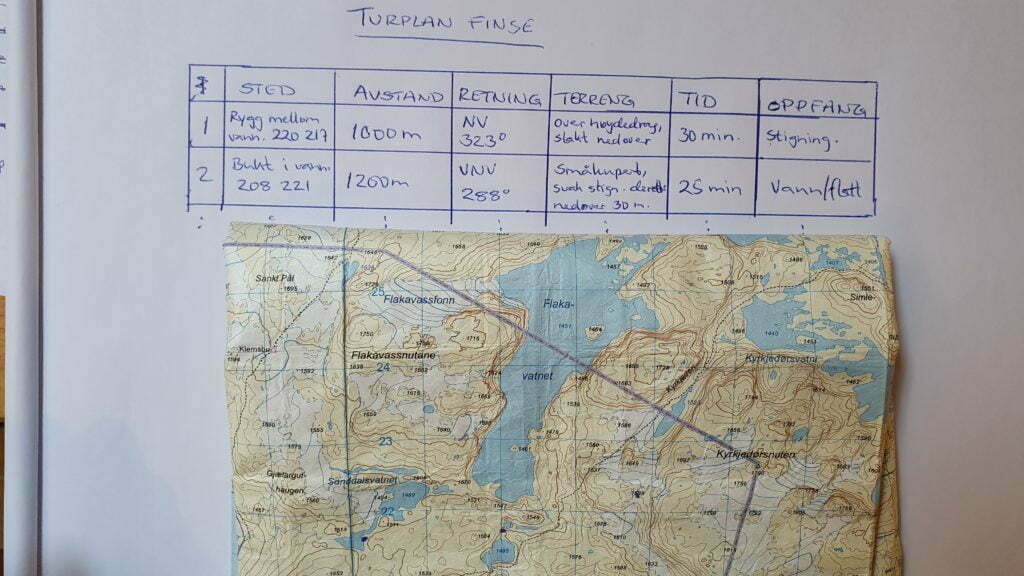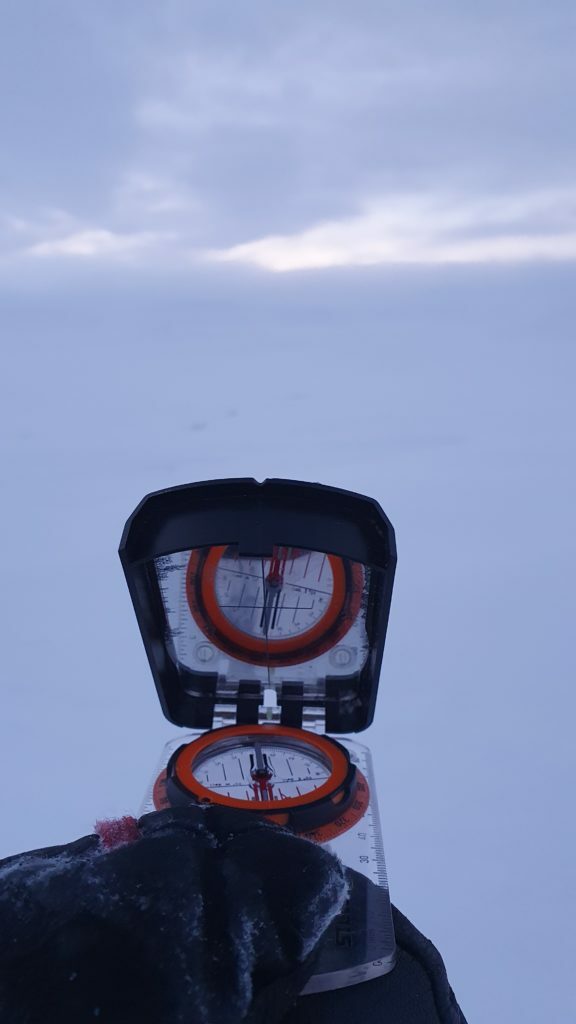
There’s nothing like finding you cabin after dark when the weather’s grim. But these conditions require good basic navigation skills with a map and compass.
Photo: Jon Hunnålvatn Tøn
1. Plan your trip.
Mark your route on the map in advance. Note places where you have to be extra vigilant, preferably with an exclamation mark. Do you pass cabins on your trip? Mark them too – preferably with a highlighter. Cabins offer emergency shelter in a crisis situation.
The route drawn on the map – including points that require attention. Photo: WildVoss
2. Always keep the map in front of you.
You’ll want a map folder. Waterproof, light, and close-fitting. I prefer transparent plastic map folders. I keep mine on a cord around the neck and fixed with a cord and carbiner to my waist. I position mine with the area I’m walking in facing my chest. This way, I avoid rain and sleet settling on the map while I walk. If I’m clever (and lucky) I can fold the map so that the last part of the trip’s visible on the reverse side of the plastic folder. Then I just turn the map folder over when I get to the last section.
3. Use a proper compass…
… and understand how to follow a bearing over long distances. Get a mirror compass. Preferably one with a clinometer built in. Attach the cord of the compass to your jacket pocket, so it’s easily accessible.

Good map-folder

Kvalitetskompass med speil og noen hendige ekstrafunksjoner
4. Read maps in good weather…
… and compare the map to reality. A map is a simplified model of reality. Many details of the terrain are left out. If reality and the map don’t say the same thing, give reality the benefit of the doubt over the map.
5. Make a table.
If you plan to travel a route with a few legs (usually a circuit), make a quick table showing:
A “too-far” point is an easily-recognisable landmark you’ll come to if you follow your bearing too far – a kind of safety net. It could be a road, a high-voltage power line, or something similar.
An example table. Photo: WildVoss
6. Actively gather information.
Perhaps landmarks are invisible because of snow. Perhaps visibility’s poor. Winter mountains can be a difficult milieu for orientation. Search your surroundings for information. Get an higher view for reading the map: climb out of stream valley, to the top of the knoll. If you can’t see much, you’re probably standing in a depression.

Use prominent features of the terrain to get an overview of the terrain you’re moving into. Photo: Jon Hunnålvatn Tøn
7. Follow shorter compass bearings.
One to two km is enough. Maximise your chances of hitting your waypoints. If your compass skills are shaky, refresh yourself on the basics.
8. Always double check your bearing.
Does your bearing make sense? Which direction on the compass are you headed? To the northwest? Then the heading should be approximately 315°. degrees. If you got 320° then you’re probably all right. But if you get 135° then you’ve put your compass in the wrong direction when you were taking your bearings.
9. Use landmarks in front of you
as you follow your compass bearings. This might be a boulder, a cliff wall, a mast, a cabin… when you’ve found a point to aim at, put the compass away and go there. Repeat the procedure. This makes movement efficient. The mirror compass is really useful here.


10. Don’t run out of energy.
It’s mentally and physically demanding to orient yourself when the weather’s bad in the winter mountains. Make sure you eat and drink regularly.
11. Use your skis as sightlines
Following a bearing in poor visibility, without aiming aiming points in the terrain ahead of you, you can keep your course by matching the edge of a ski below you to the direction of the compass ruler. Just hold the compass in front of you and line them up. It’s demanding to walk like this over long distances – but it works.

Use the ski to align yourself to your bearing when you walk in poor visibility and have no other references. Photo: WildVoss
12. Be imperfect on purpose.
When following a bearing towards a sighted target in bad weather, deliberately aim slightly to its side. Yes, you’ll miss the mark. But if you’ve prepared to miss it to its west, then you know that you should look to the east. If you were going straight for it and you miss, you won’t know whether it should be on your east or your west. In the worst case, you’ll have to look both east and west.
13. Create an expectation …
… about the next leg of your journey. Share it with your partners, or even talk to yourself: “We’ll continue eastwards on flat terrain with the low ridge formation directly to our left for about a kilometre. There the ridge turns to the north, and the terrain in front of us opens up. There we come to the lake at 1183m. We cross that on a bearing of 88° for 800 meters, until we see the cliff wall rise at the eastern end of the lake.” The purpose of anticipating is to catch mistakes early, in case you lose direction.

Recognise the terrain, learn the connection between how things look on the map and the reality. Does it make sense?
Photo: Jon Hunnålvatn Tøn

An avalanche course: the most valuable “gear” you can get
New gear is the best. Everyone loves gear. In fact, the only things better than gear are skiing and staying alive. To maintain this state of affairs, a knowledge of avalanches, navigation, terrain and the basic physics of snow is essential – it means the power to travel safely, on your own terms.

Handling hypothermia
Do you know what to do when you’re faced with someone dangerously cold? Command of the basic facts can be lifesaving – and this is just as relevant for us those of us who hit the mountains for the joy of it as it is for guide and members of the rescue services.

Avalanche skills: how to quickpit
You’re ascending a mountain. You need to assess the stability of the snow. While being safe requires gathering information every step of the way, it’s also true that no one wants to spend an hour in a snowpit, especially in bad weather. So let’s talk about “quickpits” – an efficient snow-profiling method that serves as a very good middle ground for gathering information about snow cover. The technique’s used frequently by experienced guides to gather useful – if incomplete! – intelligence while keeping toes and fingers warm. Here’s how it’s done.

Learn to use a map and compass
If you need a little refresher in the use of a map and compass (or if you’ve never learned!) step this way. You’ll have it down in no time.

Firing up the stove in winter
Nothing whets the appetite more than a long day skiing in the winter mountains. Fire up the burner, boil some water for some tea and reach for the packet of dehydrated chilli: paradise found. But doing this in the winter you need to bear a couple of things in mind. So here are some wily strategies to make things easy and safe.

Life-saving first aid in the wilds
A bad fall. A collision. Exposure. Preparation might save a life. As always, it’s a matter of planning and the right packing. With a little knowledge, some practice (and some way to contact the emergency services) you’ll have the basics covered. This could make a life-saving difference.
